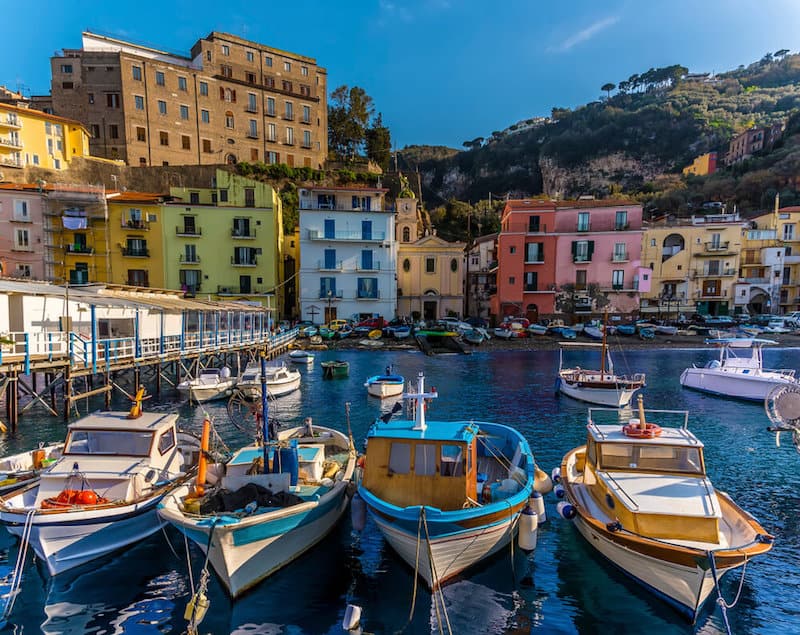Heading to Italy this year for some summer sun and want to hit the beach? Here’s a guide to the Italian coast and islands – region by region – including where to find the best beach hotels, prettiest villages, and best sandy beaches.
This guide will cover:
- coastal Italy, region by region
- the best luxury resorts and beach hotels in Italy
- the main beach resort towns in Italy; the best places to stay for nightlife and entertainment
- where to find the best quiet resorts, prettiest coastal villages, and most beautiful coastlines
- including Sicily and Sardinia, and the popular Puglia and Italian Riviera areas
Shortlist – The Best Places to Stay on the Italian Coast
- BEST INFINITY POOL: Hotel Belmond Caruso (Ravello)
- BEST HOTELS ON THE BEACH: Colonna Grand Hotel Capo Testa (Sardinia), Canne Bianche Lifestyle & Hotel (Puglia)
- BEST LUXURY HOTELS BY THE COAST: Belmond Villa Sant’Andrea (Taormina), Ma&Ma Grand Hotel (La Maddalena)
- BEST BOUTIQUE HOTELS: Sikelia Luxury Resort (Pantelleria)
- BEST VILLA: Villa Miragalli (Amalfi Coast), Stazzo Castle (Sicily)
- BEST FAMILY RESORT: Grand Palladium Sicilia Resort & Spa (Sicily)
- BEST CAMPSITE: Riviera Camping (Marche)
- BEST PLACES TO GO FOR NIGHTLIFE: Rimini, Jesolo
- BEST QUIET UNSPOILT AREAS: Gargano National Park, Cilento, Conero Riviera, Maremma
Beach Resorts in Italy – An Overview
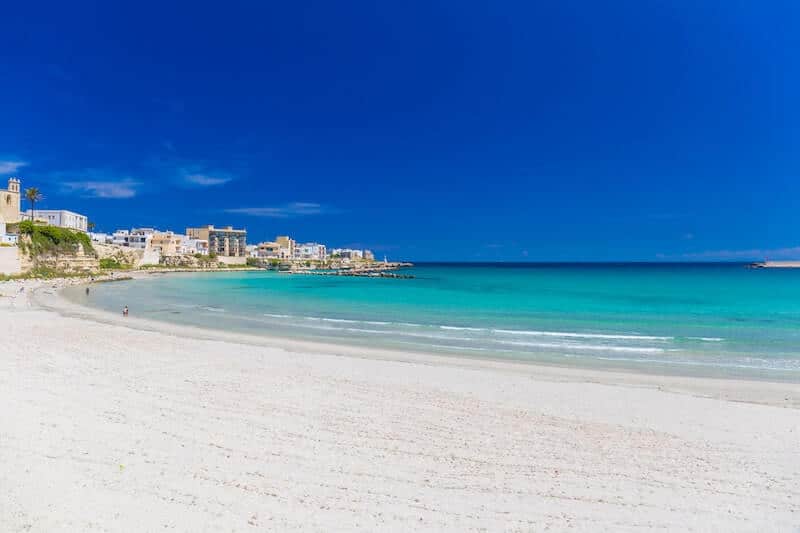
Most visitors to Italy come for its cities, leaving the beaches free for locals. Going to the beach is a popular summer past-time for Italians and the coast can get very crowded at weekends and in the August summer break.
The most common type of beach on mainland Italy is a dark golden sand colour, wide and flat. They tend to be lined with beach clubs (known variously as lido/bagni/stabilimenti ) – where you can pay by the day for facilities – not just sunloungers and cafes but also changing rooms, showers, toilets, and sometimes play areas and watersports. Many families visit the same beach club every year and have their own ‘spot’. All beaches will also have a free public section but sometimes these are less clean.
The busiest resort areas in Italy where you’ll find miles of lido beach are the Lido di Jesolo, Forte dei Marmi, Taormina and Giardini Naxos, and Rimini. You can also find lively beach suburbs on the outskirts of most coastal cities.
The best places for white sand beaches are Sardinia, Sicily, Calabria, and Puglia. You will also find many areas with steep cliffs, dramatic beaches, and beautiful coastal landscapes.
There is no shortage of 2 and 3 star traditional family-run guesthouses and seasonal hotels in Italy – many of them right on the beach. You’ll also find plenty of campsites and holiday villages catering to local families.
But all-inclusives and luxury beach resort hotels aren’t as common as you might think, with the exception of upmarket areas catering to an international crowd like the Amalfi Coast. The most characterful accommodation tends to be inland, in rustic farmhouse conversions or beautiful medieval villages.
Italian Riviera
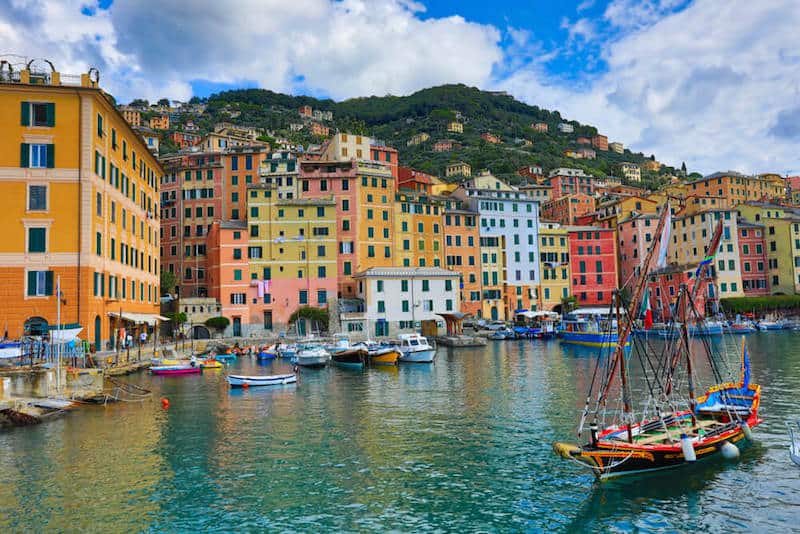
The Italian Riviera is one of the most visited regions by beach-dwelling tourists – both foreign and domestic. And for good reason. It’s compellingly beautiful – a long coast lined with colourful buildings, a buzzing summer scene, a sense of old-school glam, and delicious food.
The Riviera occupies the coastline of the coastal province of Liguria which runs from the French border around to Tuscany. It is divided into two sections – the Riviera of the Rising Sun and the Riviera of the Setting Sun, with main city Genoa in the middle. Genoa is the main access point for both air and ferry connections, although you can also access the eastern side from the port of Livorno and the airport at Pisa.
The most popular places on the Riviera are upscale Portofino, Sanremo with its casino crowd, and the pretty villages of the Cinque Terre – a favourite of Instagrammers, hikers, and cruise-ship crowds.
But what many don’t realise is that the Riviera is crammed full of towns and villages just as good-looking as these – but much less crowded – and most are connected by the train line that runs the length of the coast.
Alternative seaside towns include Alassio, Camogli (pictured above), Sestri Levante, Tellaro, Lerici, Portovenere, Bogliasco, and Levanto.
Top hotels on the Italian Riviera include:
- Cenobio dei Dogi (Camogli)
- Belmond Hotel Splendido and Belmond Splendido Mare, (Portofino)
- Grand Hotel Miramare, (Santa Marghertia Ligure)
- Hotel Helvetia (Sestri Levante)
- Excelsior Palace (Rapallo)
- Royal Hotel Sanremo (Sanremo)
Tuscan Coast
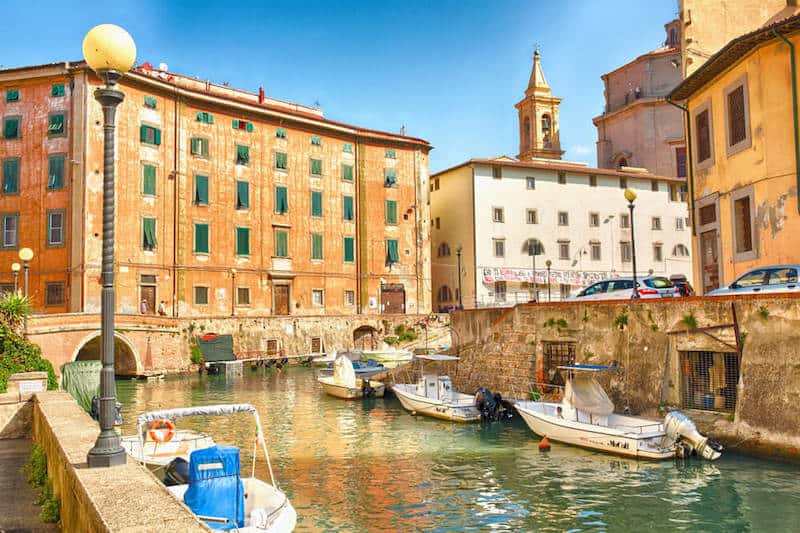
Tuscany is one of the most popular destinations for overseas visitors but most stick to the well-trodden medieval towns inland, leaving the coastline to locals those in the know.
At the northern end of the Tuscan coast is Forte dei Marmi, a seaside town known for its food market, long golden beach, and glitzy clientele. It has an excellent selection of beach hotels. The beach continues past Viareggio all the way down to Livorno, a pleasant harbour city which is a popular cruise port for accessing Pisa and Florence.
South of Livorno the coast is hillier and prettier, particularly around the Maremma Regional Park where you’ll find dramatic hills, drained swamps, quiet beaches, and oak forest Etruscan ruins. Coastal town highlights include Castiglione della Pescaia and Castilioncello.
The southern end of the Tuscan coast is the the Costa d’Argento, a unique landscape with the historic town of Orbetello wedged between two lagoons and the long isthmus beaches of Feniglia and Giannella that link the cape the mainland. There’s a resort town – Porto Ercole and Porto Santo Stefano – on either side of the cape.
Pretty seaside villages include Castiglioncello, Castiglione della Pescaia, Talamone, and he small and exclusive Punta Ala.
A short distance offshore is the Tuscan Archipelago, home to the majestic Elba island – one of Italy’s most beautiful islands and also a popular summer destination with domestic tourists. It has picturesque towns such as Portoferraio and Porto Azzuro and wonderful pristine nature. Smaller islands in the chain include Giglio and Pianosa.
There is an international airport at Pisa.
The best hotels on the Tuscan coast are:
- Gran Hotel Imperiale (Forte dei Marmi)
- Grande Hotel Principe di Piemonte (Forte dei Marmi)
- Hotel Hermitage (Elba)
- Argentaria Golf Resort and Spa (Porto Ercole)
- Il Pellicano (Porto Ercole)
Lazio Coast
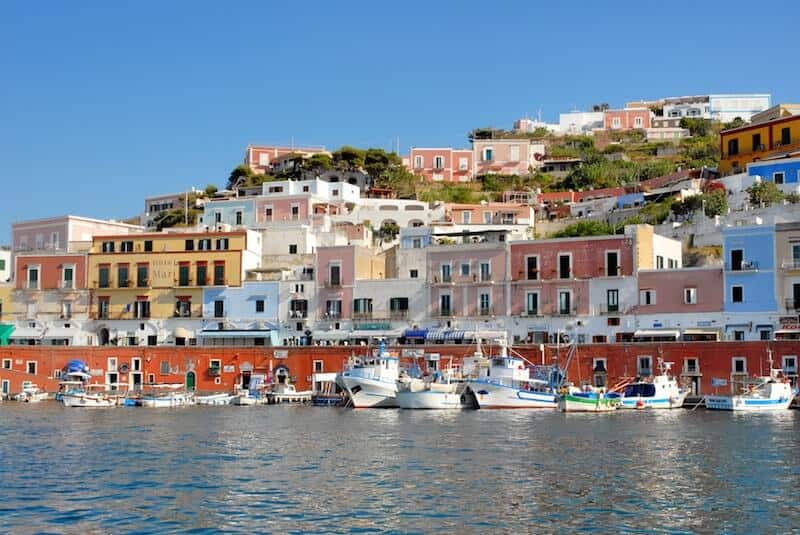
Lazio is the region south of Tuscany and life here revolves around Italy’s capital Rome. The coast is home to several large port cities, the only ones familiar to tourists is likely to be Civitavecchia which is the main cruise port for Rome and the impressive ancient ruins of Ostia Antica
Many of the smaller coastal towns such as Anzio and Nettuno within commuting distance of Rome and summer tourism is geared towards holidaying Romans. The coastline around here is flat and beaches are a dark golden colour with plenty of beach clubs.
South of Anzio are the quiet beaches of the rugged Circeo National Park.
Pleasant small seaside resorts along the coast include Santa Severa, Terracina, and Sperlonga, but the real highlight is the historic coastal city Gaeta in the south. Popular with Italian tourists, it has a large sandy beaches and heaps of history. Behind the city is parkland and trails of Monte Orlando.
There are a few small islands off the southern shore which form the Pontine Archipelago and are popular with weekend visitors from the city. Of these islands, it’s possible to stay on Ponza (pictured above) – the most visited – and Ventotene.
Rome has two international airports.
Top hotels on the Lazio coast include:
- Grand Hotel Chiaia di Luna (Ponza)
- Grand Hotel Santa Domitilla (Ponza)
- Villa Irlanda Grand Hotel (Gaeta)
- Grand Hotel Le Rocce (Gaeta)
Campania
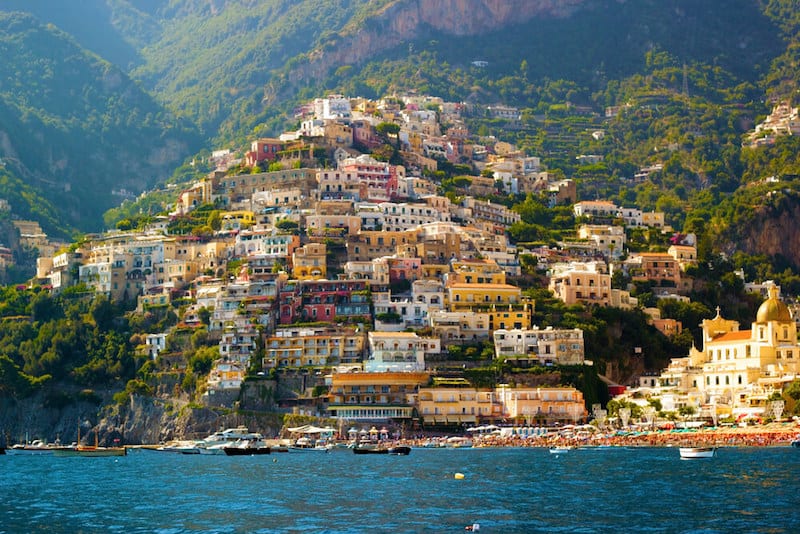
Heading south, Campania is one of the Italian coastal regions most familiar to international visitors thanks to the world-famous splendours of the Bay of Naples – notably the Amalfi Coast and Capri.
Major city Naples is one of the biggest ports in Italy and the gateway to the bay including the glamorous islands Capri and Ischia, and the photogenic small fisherman island Procida.
A train line runs south of Naples around the bay past Vesuvius, the archaeological sites and Pompeii and Herculaneum, and all the way around to popular coastal resort Sorrento.
The iconic Amalfi Coast lies on the southern side of this peninsula, incorporating the famous villages (Atrani, Positano, Minori, Maiori, Praiano, Ravello, and Furore).
At the eastern end of the Amalfi Coast is the small port city of Salerno, a cheaper and less pretentious alternative base for the region.
There is an international airport at Naples.
Best hotels in the Bay of Naples include:
- JK Palace (Capri)
- Grand Hotel Excelsior Vittoria (Sorrento)
- Il San Pietro di Positano (Positano)
- Le Sirenuse (Positano)
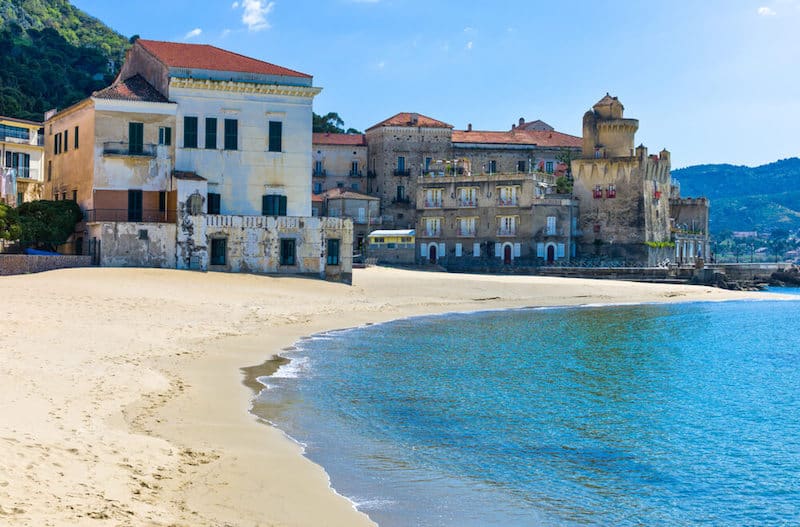
The coastline beyond Salerno is less well known but the coastal scenery of the Cilento National Park is just as pretty and is home to UNESCO-listed Ancient Greek ruins. Beach resort towns to make a beeline for are Santa Maria di Castellabate (pictured above), Pisciotta, and Marina di Camerota.
A stylish stay in Cilento is the chic boutique Palazzo Gentilcore (Castellabate).
Basilicata
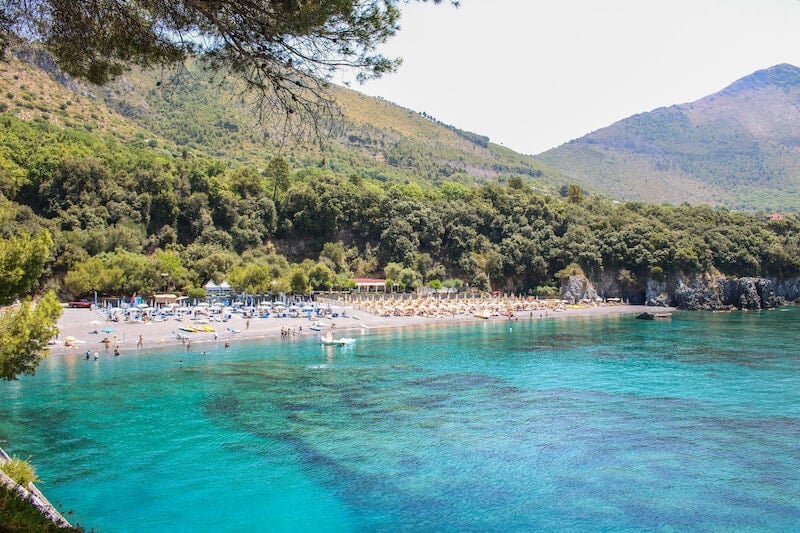
Basilicata is a large region which straddles two coastlines (Tyrrhenian and Ionian) and is little visited by foreigners.
The western (Tyrrhenian) coast is wedged between the Cilento and Calabria. It’s short and mountainous. Head to the picturesque village Maratea which has dozens of churches and an attractive harbour (stay at Santavenere Hotel). There’s a beach nearby at Macarro.
Over on the eastern side, the Ionian shoreline is flatter and home to family-friendly lido beaches and the occasional ancient ruin.
The nearest international airport is Bari.
Calabria
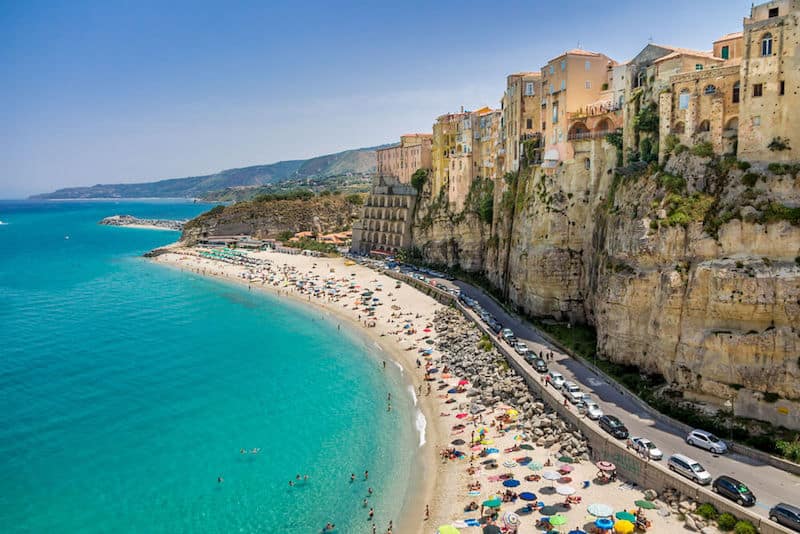
Calabria – is Italy’s sun-drenched Deep South. It’s slowly becoming more known as a tourist destination, but is still off the beaten track. It’s a great destination for beach-lovers with a sense of adventure. Expect great food, warm people. Calabria has two coastlines – Tyrrhenian and Ionian.
The most well-known beach destination is the striking clifftop town of Tropea (pictured above) which is surrounded by fantastic sandy beaches and the turquoise Tyrrhenian Sea. It’s overlooked by a 6th century monastery on a rock. The coastline either side of Tropea (the Capo Vaticano and Zambrone) has steep cliffs and isolated beaches. It’s known as the Costa degli Dei – The Coast of the Gods.
But it’s not the only photogenic spot on the Calabrian coast – check out fishing villages Scilla, Palmi, Amantea, Pizzo, and Diamante.
At the far end of Calabria is the coastal city Reggio Calabria, an underrated destination itself with ferries across the Messina Strait to Sicily.
The main beach resort towns in Calabria are Soverato, which has a big sandy beach, Catanzaro Lido, and Copanello, Bagnara Calabra.
Up in the north of the region is the town San Nicola Arcella, with nearby resorts Maratea (technically in Basilicata), Scalea and Praia a Mare. Underwater caves make it a prime destination for divers and there are lots of boat trips around the coast.
The Ionian side of Calabria has a few scenic spots worth stopping at if you’re driving around – Le Castella with its Aragonese castle, the Greek ruins at Capo Colonna. The beaches are mainly long and gravelly with clear water, and a short uphill drive to pretty villages.
International airports are at Lamezia Terme and Reggio Calabria.
The best coastal hotels in Calabria include:
- Rocca della Sena (Tropea)
- Il Borghetto Creative Resort (Tropea)
- Villa Paola (Tropea)
- Oldwell Beachfront Hotel (Tropea)
Puglia
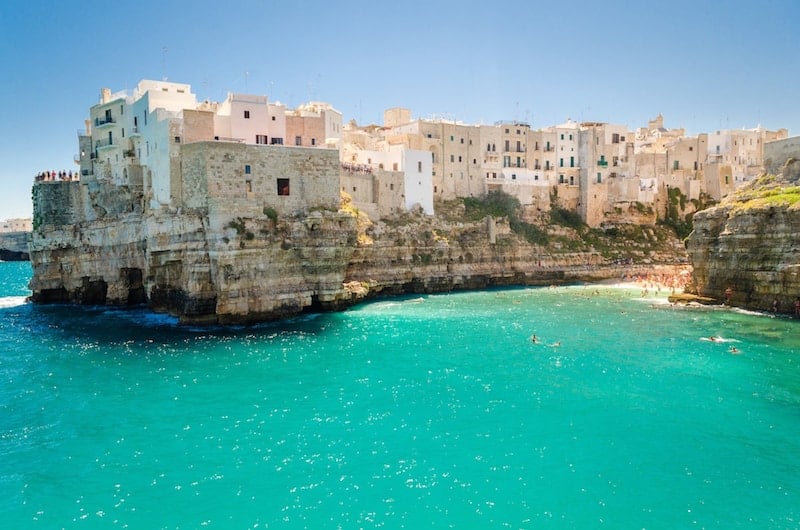
Over the past few decades Puglia has really exploded in popularity thanks to its unique combination of white sand beaches, turquoise waters, and whitewashed medieval towns.
Looking at a map, the Salento Peninsula is the ‘heel’ part of Italy but Puglia also includes land up to and including the ‘spur’, which is the Gargano National Park. The Gargano is one of the most scenic and unspoiled coastal areas of Italy, with spectacular beaches and clifftop towns like Vieste as well as the tiny Tremiti archipelago 12km offshore.
The best white sand beaches and also the region’s most popular resort areas are found on the southern tip and coast of the Salento Peninsula. Porto Cesareo and Pescoluse is well-known for their exotic beaches.
The prettiest coastal villages are Polignano a Mare, Gallipoli, and Monopoli, and the resort area of Otranto which is also home to a marine park with stunning coastal scenery.
Many of the areas attractions are inland rather than by the coast, such as the beautiful city Lecce, medieval villages like Ostuni, and the famous beehive houses of Alberobello.
There are international airports at Bari and Brindisi. Both cities also have appealing old towns and international ferry connections.
The best beach hotels in Puglia are:
- La Peschiera (Fasano)
- Grotta Palazzese Beach Hotel (Polignano a Mare)
- Canne Bianche Lifestyle & Hotel (Torre Canne)
- Capase Resort (Santa Cesarea Terme)
- Posia Luxury Retreat & Spa (San Foca)
For more read: Where to Stay in Puglia – Ultimate Beach Resort Guide
Abruzzo and Molise
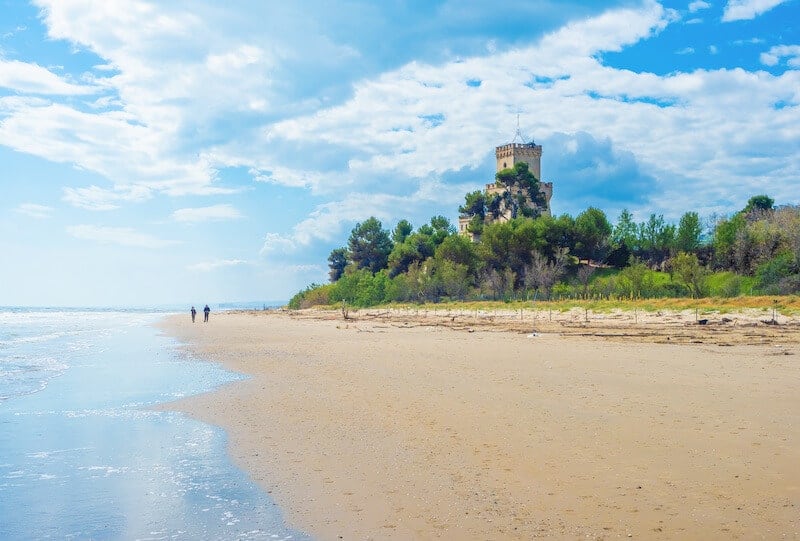
Abruzzo and Molise are two little-visited regions and the coastlines of the Abruzzo and Molise don’t contain any big-hitter attractions or standout beaches. They are known for their mountains and national parks rather than their beaches.
As such, they remain laid-back, unpretentious, and great value. There are plenty of clean sandy beaches in flat green areas which are popular with local families.
North of the Gargano National Park is the short stretch of coast belonging to Molise. It has wide sand beaches with traditional resorts, the most popular are Termoli and Campomarina. A quieter highlight is the undeveloped coast around Petacciato.
The Abruzzo coast is roughly divided into 3 provinces: Chieti in the south, Pescara, and Teramo in the north. The Chieti shoreline is a rocky and known for its wooden fishing platforms on stilts called trabocchi. Head to Vasto for sand and lidos, or Ortona for harbourside history.
Sandy beaches resume around Pescara. Popular areas include the beach suburb Montessilvano and historic seaside resort Francavilla al Mare.
The Teramo coastline is long and flat with lots of wide beaches, traditional resorts, holiday villages, campsites, waterparks, and family-friendly lidos. The main resorts are Martinsicuro, Alba Adriatica, Tortoreto, Giulianova, Roseto, and Pineto (pictured above).
The most scenic area is the Punta Aderci Nature Reserve. It has a slightly dated feel but excellent coastal walks.
There is an international airport and ferry port at Pescara.
Standout beach hotels include:
- Baia Delphis Resort (Vasto)
- Hotel 900 (Giulianova)
- Dimore di Mare (Termoli)
Le Marche

The region of Le Marche is a haven for beach-lovers. The coastline is home to some dramatic and beautiful beaches. It’s clean, traditional, family friendly, uncrowded, and has a wide variety of landscapes.
Le Marche has most Blue Flag beaches of any area in Italy. Some of the beaches here are reminiscent of those across the water in Greece’s Ionian Islands – with dazzling white pebbles, emerald seas, and abrupt limestone cliffs. Others resemble the pebble beaches of Croatia. And some are typically Italian with their wide golden sands and stripy sunloungers. Inland you’ll find rolling hills and pretty medieval villages.
There are many big seaside resorts in Le Marche with long sandy lido beaches and a lively atmosphere. Pesaro, Grottammare, and Senigallia are the most appealing for foreigners, with history and character as well as good facilities and a buzzing summer nightlife. Singallia has a 13km long sandy Blue Flag beach, and San Benedetto del Tronto has a promenade lined with thousands of palm trees and landscaped gardens, and is known for its food.
For pretty coastal towns, quieter beaches, and dramatic coastal scenery check out the Conero National Park just south of Ancona which is home to steep cliff beaches (like the Due Sorelle) and emerald seas. Stay at Numana or Sirolo.
At the northern end of Le Marche, the Monte San Bartolo Regional Park is a wild coast with walking trails. Stay in nearby Pesaro or Gabicce Mare.
There’s an international airport and ferry connections at Ancona, which itself has a small hilltop old town and beach suburbs.
Stylish places to stay on the Marche coast are:
- Hotel Excelsior (Pesaro)
- Riviera Camping (Marche)
- Hotel Fortino Napoleonico (Conero)
- Terrazza Marconi Hotel & Spa (Senigallia)
Emilia-Romagna

Emilia-Romagna is home to Rimini, one of Italy’s best known traditional beach resort towns. The surrounded coastline is known as the Adriatic Riviera and is popular with Italians of all generations. The coastline is flat reclaimed marshland and the sea is a bit murky, but the beach are vast and lined with beach clubs.
The Adriatic Riviera is known for its nightlife and brash retro fun. There’s every type of entertainment on offer including water parks, boat trips, and theme parks. As well as Rimini, other lively resorts include Riccione, Cervia, and Cattolica.
For a different vibe, there are a few picturesque canal towns at river mouths where you can find traditional boats and buildings including Comacchio (not far from UNESCO-listed art town Ravenna) and Cesenatico.
There is an international airport at Rimini.
Best hotels along the Adriatic Riviera include:
- Grand Hotel (Rimini)
- i-Suite (Rimini)
- Hotel Select Suites & Spa (Riccione)
- Carducci 76 (Cattolica)
Veneto

The big draw in the Veneto Region is Venice however its coastal resorts are a popular getaway for northern Italians as well as international visitors who don’t want to stay in the city itself. As such there is a higher concentration of all-inclusive resort hotels here.
The coastline is a continuation of the Adriatic Riviera with its wide sandy beaches and plentiful entertainment. The busiest is Jesolo which is just outside Venice and rivals Rimini for nightlife and lively beaches.
Other major resorts in the region include Bibione and Chioggia, as well as Caorle which has a beautiful old town. For quiet unspoiled lagoon beaches try the Valle Vecchia Natural Park nearby, or head south to the wetlands and dunes of the Po Valley.
The nearest international airports is Venice.
Best hotels near the beach in the Veneto include:
- Colonia Resort (Vittorio Veneto)
- JW Marriott Venice Resort & Spa (Venice)
- Hotel Excelsior Venice Lido
Friuli-Venezia-Giulia

Fruili-Venezia-Giulia is Italy’s easternmost region. The liveliest coastal resort here is Lignano Sabbiadoro (pictured above) which is located on the Veneto border and the western edge of the Marano Lagoon. Lignano has the sandiest beach and this is where you’ll find the highest concentration of holidaymakers – Austrians as well as Italians.
On the other side of the lagoon is the charming fishing town Grado. Boat trips around the lagoon are a popular activity.
Past Grado, the coast gets steeper and rockier and the beaches smaller towards harbour city Trieste, which is not really a beach destination however swimming in the sea is a common past-time. There are plenty of small pebble beaches and rocky platforms with facilities on the coast either side of the city. For a stay outside the city, try the Portopiccolo Sistiana area.
There is an international airport at Trieste.
Top stays in Fruili-Venezia-Giulia include:
- Falisia Resort & Spa (Sistiano)
- Boutique Hotel Oche Selvatiche (Grado)
- Hotel Riviera & Maximilian’s (Trieste)
Sicily
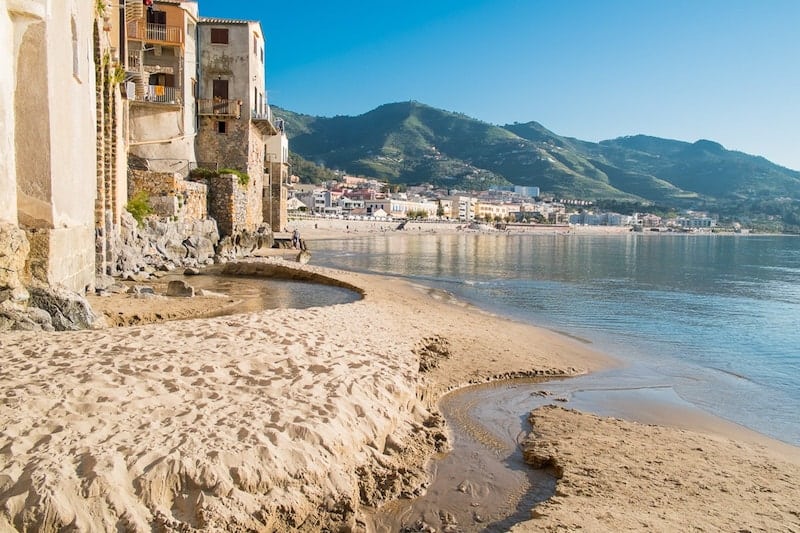
Much of Sicily is unspoiled by mass tourism although this doesn’t necessarily mean undeveloped. The island is a favourite beach destination with domestic tourists.
The liveliest resort towns and the best for nightlife are the popular San Vito Lo Capo, Cefalu, Giardini Naxos and Taormina. The coastlines around these resort towns as well as the cities are lined with lidos, organised beaches, and family-friendly holiday villages and resorts.
For quiet unspoiled beaches head to the south coast around Agrigento.
Fly in to Palermo and you are close to Cefalu with its Arab-Normal cathedral and sandy beach. There are family-friendly stays at the many hotels that line the nearby coastlines – some available though tour operators. Head west of Palermo and find some of the prettiest coastal scenery around the picture-perfect Scopello and the Zingaro Nature Reserve. The area towards Trapani and Marsala is home to some of the best sandy beaches on Sicily and is more popular with domestic than foreign tourists.
Fly in to Catania and you’re not far from the ever-popular classic Italian resort of Taormina. This is the most touristy party of Sicily. The beaches around here vary but it’s chock full of cultural delights – Etna and the Aeolian Islands are within reach, plus the beautiful cities of Syracuse and the baroque Val di Noto towns.
The south east is an undiscovered highlight – with lovely beaches and scenery of the Cavagrande, Marzamemi and the Vendicari Nature Reserve.
Don’t miss the minor islands surrounding Sicily. The Aeolian Islands are popular for their variety and volcanic landscape – hushed Panarea is romantic and exclusive. The Egadian Islands off the coast of Trapani are tiny and beautiful. And the rugged Lampedusa is home to some fantastic beaches and diving.
There are international airports at Palermo, Catania, and Comiso.
The best beach hotels on Sicily are:
- Belmond Villa Sant’Andrea (Taormina)
- Calette N5 (Cefalu)
- Sikelia Luxury Resort (Pantelleria)
- Capo San Vito (San Vito Lo Capo)
- La Plage (Taormina)
For more read: Where to Stay on Sicily: Ultimate Beach Resort Guide
Sardinia
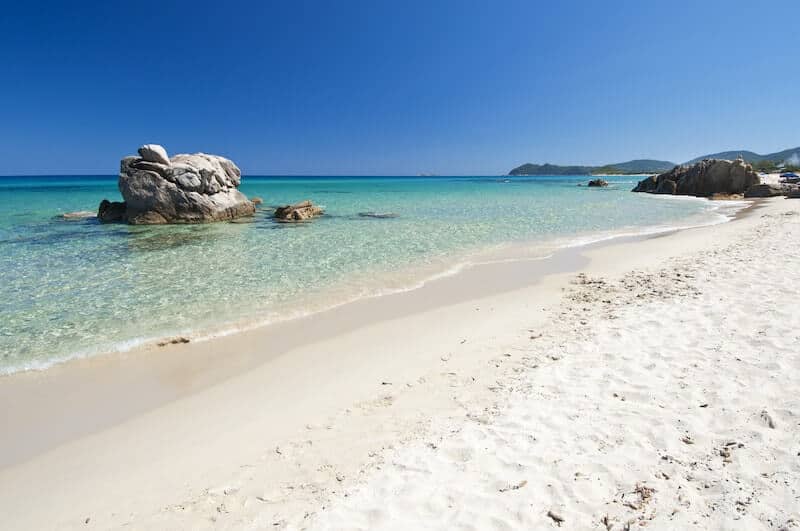
The island of Sardinia is Italy’s premier beach resort destination. If white sand is your thing then the island of Sardinia will delight you. The area is popular with domestic tourists although there is international tourism and a package tour presence in a few areas.
Coastal resorts are mostly modern and low-key, with traditional villages found in the lush mountainous interior. Sandy beaches are spread equally around the island. The beaches on the north and south tips are particularly pretty thanks to the distinctive granite boulders on the beach, especially around Capo Testa .
Luxury tourism is concentrated around the beautiful (and exclusive) Costa Smeralda area, including the beautiful La Maddalena Archipelago.
Better value – but just as beautiful alternatives – include the Costa Rei , Golfo Aranci, and Chia areas.
The island as a whole is suitable for families but particularly so on the east coast where the waters are calmer. South of Olbia are many family friendly resorts, campsites, and big lagoon beaches. Popular family-friendly resorts include San Teodoro, Budoni, and Villasimius
For wilderness, head to the wild Costa Verde or the rugged Golfo di Orosei.
Big cities Alghero and Cagliari make a buzzing base with plenty of beaches within reach.
There are international airports at Alghero, Cagliari, and Olbia.
The best beach hotels on Sardinia are:
- Ma&Ma Grand Hotel (La Maddalena)
- Pitrizza (Costa Smeralda)
- Romazzino (Costa Smeralda)
- Forte Village Resort (Pula)
For more read: Where to Stay on Sardinia: Ultimate Beach Resort Guide
You might also be interested in the following:
10 Most Beautiful Beaches in Italy
10 Best Sandy Beaches in Italy
10 Most Beautiful Islands in Italy
Where to Stay in Greece: Ultimate Beach Resort Guide
Where to Stay in Spain: Ultimate Beach Resort Guide
10 Most Beautiful Beaches on Sicily
10 Most Beautiful Beaches on Sardinia
10 Colourful Towns & Villages in Italy
10 Most Beautiful Italian Coastlines
10 Best Coastal Cities in Italy
Enjoyed this post? Follow us on Facebook or Twitter.
Click to save to Pinterest:

Image credits:
Sorrento: © Nicola Pulham / Shutterstock
Otranto: © jsk12 / Adobe Stock
Italian Riviera: © aceshot1 / Shutterstock
Livorno: © Fortgens Photography / Shutterstock
Ponza, Lazio: © claudiozacc / Adobe Stock
Positano: © ronnybas frimages / Shutterstock
Cilento: © Gimas / Shutterstock
Basilicata: © laudibi
Calabria: © Diego Grand / Shutterstock
Puglia: © Marco Saracco
Abruzzo: © ValerioMei / Adobe Stock
Le Marche: © zm_photo / Adobe Stock
Rimini, Emilia-Romagna: © oneinchpunch
Veneto: © duesV / Adobe Stock
Friuli-Venezia-Giulia: © babsi_w / Adobe Stock
Cefalu, Sicily: © The Mediterranean Traveller
Costa Rei, Sardinia: © goreme / Adobe Stock
Capri (in collage): © evannovostro / Adobe Stock

